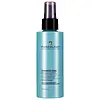What's inside
What's inside
 Key Ingredients
Key Ingredients

No key ingredients
 Benefits
Benefits

 Concerns
Concerns

 Ingredients Side-by-side
Ingredients Side-by-side

Water
Skin ConditioningPolyacrylamide
Phenoxyethanol
PreservativeAmodimethicone
C13-14 Isoparaffin
EmollientIsopropyl Myristate
EmollientParfum
MaskingLaureth-7
EmulsifyingXylose
HumectantHydrolyzed Soy Protein
HumectantTrideceth-6
EmulsifyingHydrolyzed Vegetable Protein Pg-Propyl Silanetriol
Skin ConditioningArginine
MaskingCitric Acid
BufferingCetyl Alcohol
EmollientCetrimonium Chloride
AntimicrobialBehentrimonium Methosulfate
Benzyl Benzoate
AntimicrobialQuaternium-33
Limonene
PerfumingBenzyl Alcohol
PerfumingLinalool
Perfuming2-Oleamido-1,3-Octadecanediol
Skin ConditioningWater, Polyacrylamide, Phenoxyethanol, Amodimethicone, C13-14 Isoparaffin, Isopropyl Myristate, Parfum, Laureth-7, Xylose, Hydrolyzed Soy Protein, Trideceth-6, Hydrolyzed Vegetable Protein Pg-Propyl Silanetriol, Arginine, Citric Acid, Cetyl Alcohol, Cetrimonium Chloride, Behentrimonium Methosulfate, Benzyl Benzoate, Quaternium-33, Limonene, Benzyl Alcohol, Linalool, 2-Oleamido-1,3-Octadecanediol
Water
Skin ConditioningCocos Nucifera Oil
MaskingAmodimethicone
Polyquaternium-37
PPG-5-Ceteth-10 Phosphate
EmulsifyingPhenoxyethanol
PreservativePropylene Glycol Dicaprylate/Dicaprate
EmollientParfum
MaskingAcetamide Mea
HumectantSodium Hydroxide
BufferingLactamide Mea
HumectantDimethicone PEG-7 Phosphate
CleansingHydrolyzed Vegetable Protein Pg-Propyl Silanetriol
Skin ConditioningPPG-1 Trideceth-6
Skin ConditioningBehentrimonium Chloride
PreservativeTrideceth-6
EmulsifyingCoriandrum Sativum Seed Oil
EmollientTocopherol
AntioxidantXylose
HumectantButylene Glycol
HumectantHexadimethrine Chloride
Sorbitan Oleate
EmulsifyingPoly(Linseed Oil)
Isopropyl Alcohol
SolventCetrimonium Chloride
AntimicrobialHelianthus Annuus Seed Extract
Skin ConditioningPropylene Glycol
HumectantBenzophenone-4
UV AbsorberBenzyl Alcohol
PerfumingGeraniol
PerfumingPotassium Sorbate
PreservativeBHT
AntioxidantChamomilla Recutita Flower Extract
MaskingCitrus Limon Fruit Extract
MaskingCI 42090
Cosmetic ColorantCI 17200
Cosmetic ColorantWater, Cocos Nucifera Oil, Amodimethicone, Polyquaternium-37, PPG-5-Ceteth-10 Phosphate, Phenoxyethanol, Propylene Glycol Dicaprylate/Dicaprate, Parfum, Acetamide Mea, Sodium Hydroxide, Lactamide Mea, Dimethicone PEG-7 Phosphate, Hydrolyzed Vegetable Protein Pg-Propyl Silanetriol, PPG-1 Trideceth-6, Behentrimonium Chloride, Trideceth-6, Coriandrum Sativum Seed Oil, Tocopherol, Xylose, Butylene Glycol, Hexadimethrine Chloride, Sorbitan Oleate, Poly(Linseed Oil), Isopropyl Alcohol, Cetrimonium Chloride, Helianthus Annuus Seed Extract, Propylene Glycol, Benzophenone-4, Benzyl Alcohol, Geraniol, Potassium Sorbate, BHT, Chamomilla Recutita Flower Extract, Citrus Limon Fruit Extract, CI 42090, CI 17200
Ingredients Explained
These ingredients are found in both products.
Ingredients higher up in an ingredient list are typically present in a larger amount.
This water-soluble silicone is used for its hydrating and softening properties. It is used to add a silky feel to skincare products and has great benefits for haircare.
In haircare, this ingredient:
- Adds shine
- Protects color
- Offers thermal protection
- Boosts hair strength
- Does not build up as easily
Benzyl Alcohol is most commonly used as a preservative. It also has a subtle, sweet smell. Small amounts of Benzyl Alcohol is not irritating and safe to use in skincare products. Most Benzyl Alcohol is derived from fruits such as apricots.
Benzyl Alcohol has both antibacterial and antioxidant properties. These properties help lengthen the shelf life of products. Benzyl Alcohol is a solvent and helps dissolve other ingredients. It can also improve the texture and spreadability.
Alcohol comes in many different forms. Different types of alcohol will have different effects on skin. This ingredient is an astringent alcohol.
Using high concentrations of these alcohols are drying on the skin. They may strip away your skin's natural oils and even damage your skin barrier. Astringent alcohols may also irritate skin.
Other types of astringent alcohols include:
According to the National Rosacea Society based in the US, you should be mindful of products with these alcohols in the top half of ingredients.
Any type of sanitizing product will have high amounts of alcohol to help kill bacteria and viruses.
Learn more about Benzyl AlcoholThis ingredient is a preservative, antimicrobial, and emulsifier. It is often used in cosmetics for its ability to cleanse, condition, and reduce static.
Cetrimonium chloride is a quaternary ammonium salt, meaning it has a water-soluble structure.
We don't have a description for Hydrolyzed Vegetable Protein Pg-Propyl Silanetriol yet.
Parfum is a catch-all term for an ingredient or more that is used to give a scent to products.
Also called "fragrance", this ingredient can be a blend of hundreds of chemicals or plant oils. This means every product with "fragrance" or "parfum" in the ingredients list is a different mixture.
For instance, Habanolide is a proprietary trade name for a specific aroma chemical. When used as a fragrance ingredient in cosmetics, most aroma chemicals fall under the broad labeling category of “FRAGRANCE” or “PARFUM” according to EU and US regulations.
The term 'parfum' or 'fragrance' is not regulated in many countries. In many cases, it is up to the brand to define this term.
For instance, many brands choose to label themselves as "fragrance-free" because they are not using synthetic fragrances. However, their products may still contain ingredients such as essential oils that are considered a fragrance by INCI standards.
One example is Calendula flower extract. Calendula is an essential oil that still imparts a scent or 'fragrance'.
Depending on the blend, the ingredients in the mixture can cause allergies and sensitivities on the skin. Some ingredients that are known EU allergens include linalool and citronellol.
Parfum can also be used to mask or cover an unpleasant scent.
The bottom line is: not all fragrances/parfum/ingredients are created equally. If you are worried about fragrances, we recommend taking a closer look at an ingredient. And of course, we always recommend speaking with a professional.
Learn more about ParfumPhenoxyethanol is a preservative that has germicide, antimicrobial, and aromatic properties. Studies show that phenoxyethanol can prevent microbial growth. By itself, it has a scent that is similar to that of a rose.
It's often used in formulations along with Caprylyl Glycol to preserve the shelf life of products.
We don't have a description for Trideceth-6 yet.
Water. It's the most common cosmetic ingredient of all. You'll usually see it at the top of ingredient lists, meaning that it makes up the largest part of the product.
So why is it so popular? Water most often acts as a solvent - this means that it helps dissolve other ingredients into the formulation.
You'll also recognize water as that liquid we all need to stay alive. If you see this, drink a glass of water. Stay hydrated!
Learn more about WaterWe don't have a description for Xylose yet.